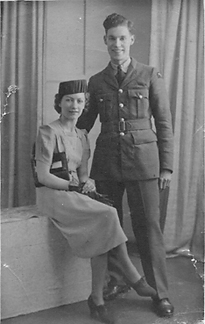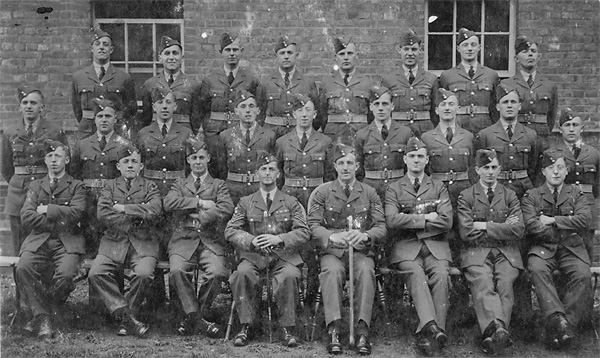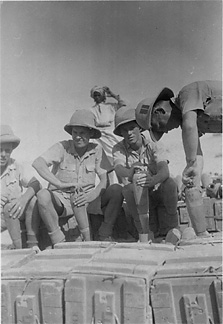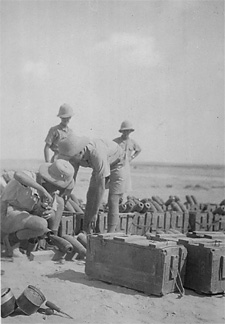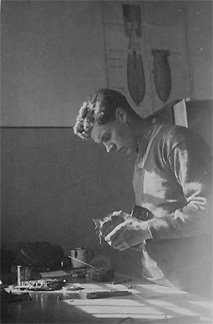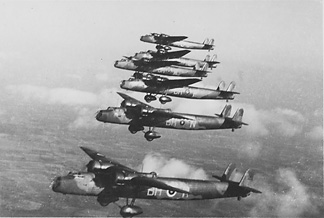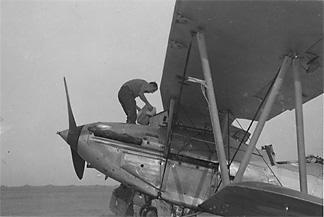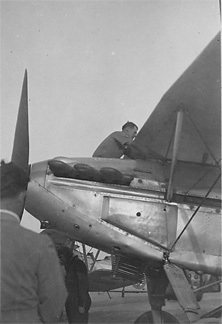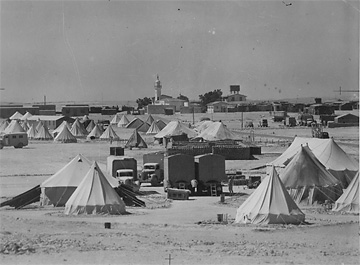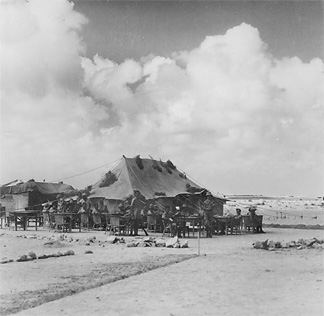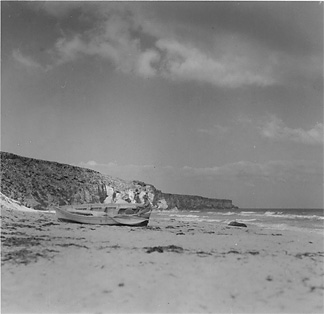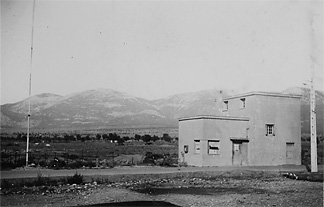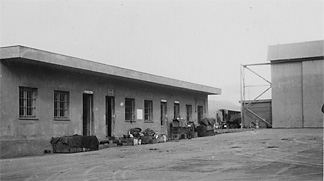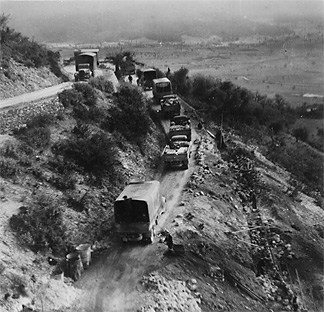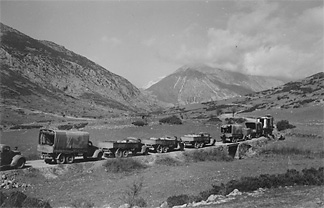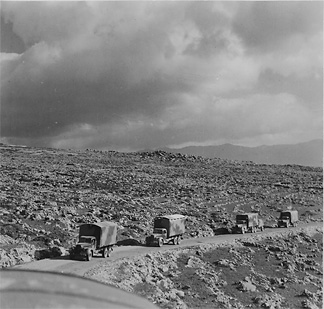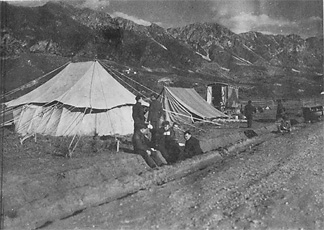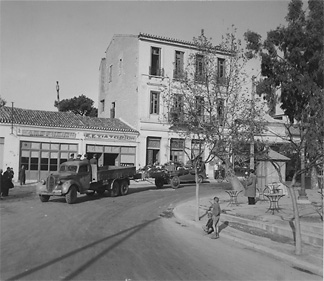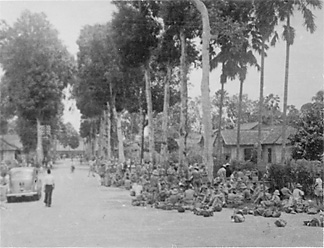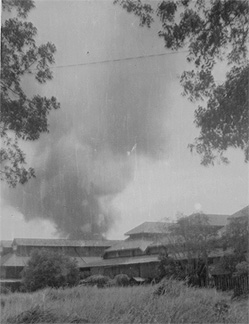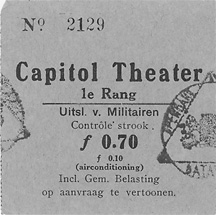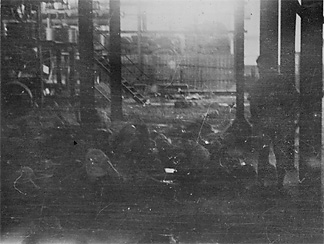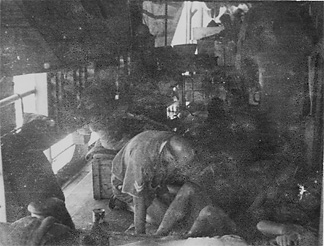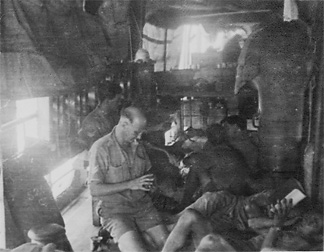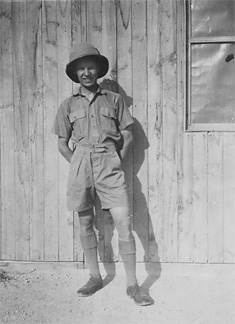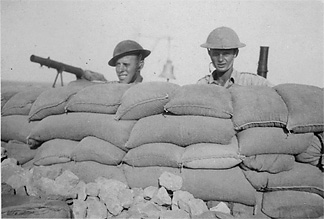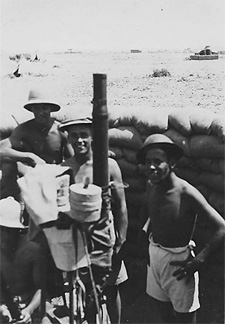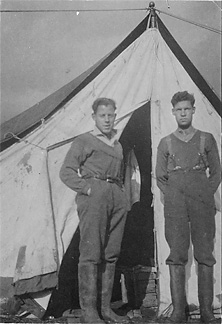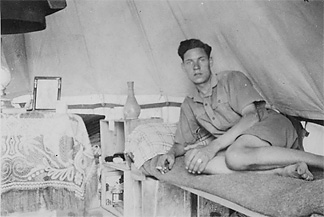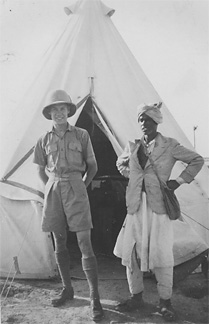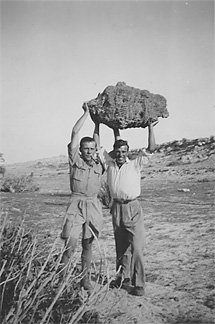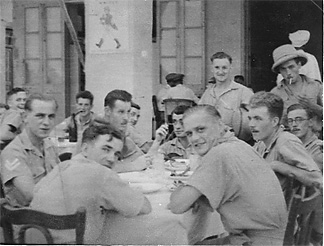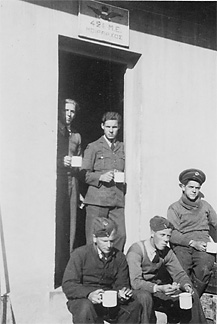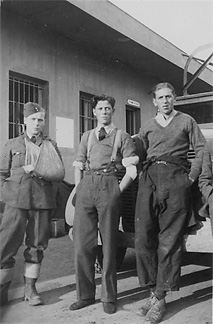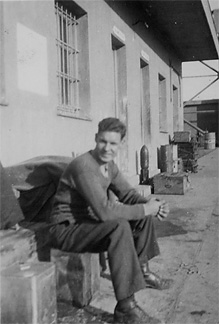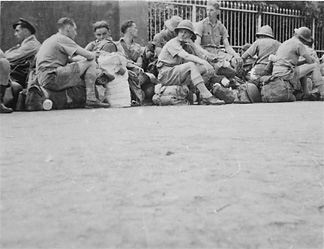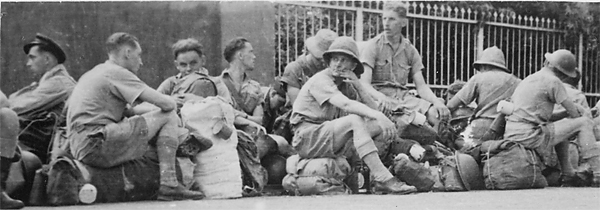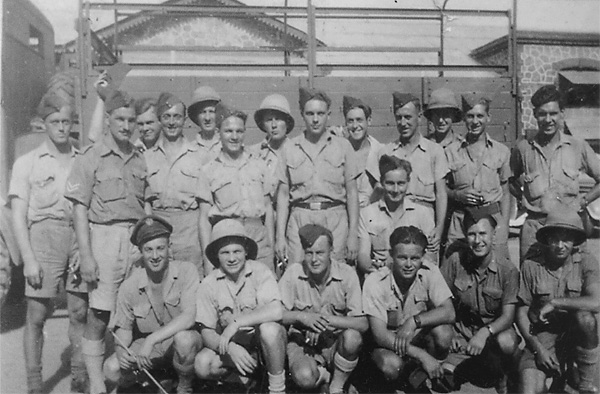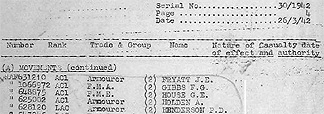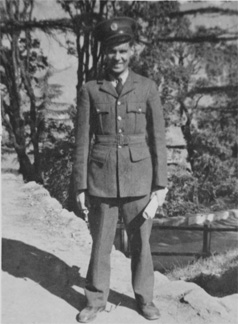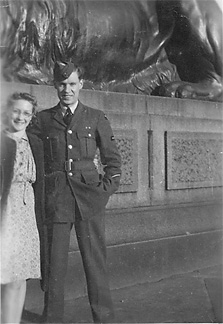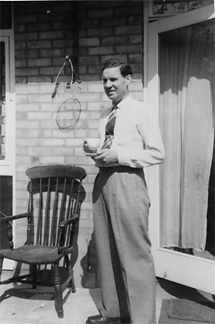 |
 |
|||||||||||||||||||||||||||||||||||||||||||||
|
LAC James Edward "Jim" Fryatt 631210 RAFVR 1918—2008 Jim Fryatt had not long turned 20 when, in January 1939, he went to Uxbridge Depot and joined the RAF. Perhaps his prescience was prompted by a sense of adventure and thoughts of a change from the building trade in Willesden. Now thrive the armourers... Encouraged by his step up and with posting overseas imminent, he and Joan married on 6 March 1940. Within a week his posting was notified: he was on his way to the Middle East and 211 Squadron in the Western Desert as an AC1 Armourer.
Their wedding day going away portrait. Jim kept a framed print in his tent. Made LAC Armourer in October 1940, he stayed with the Squadron through all the Middle East period and the transfer to the Far East. Jim was one of the lucky ones, escaping the fall of Java in March 1942 aboard 205 Squadron's tender RAFA Tung Song to Australia. Later serving in India, in June 1943 Jim Fryatt was fortunate once more, posted home to No 1656 Conversion Unit at Lindholme in South Yorkshire. There the training of aircrew on Lancasters was to draw Jim into further technical expertise, at No 10 School of Technical Training for the Boulton-Paul turret course, to continue with 1656 HCU as it became No 1 Lancaster Finishing School. Late in 1944, the unit disbanded at RAF Hemswell in Lincolnshire, where Jim saw out the end of the war. He marched out of the RAF from No 102 Personnel Despatch Centre in January 1946, an LAC Armourer with the Africa Star and a good conduct badge. Photograph collection Jim’s son Adrian keeps the family tin of photos safe today, and has kindly made part of the collection available for this site. Few of the originals bear any description, so the following notes have been provided variously by Adrian, by Len or Mick, and by me. There is such variety in the photographs that several themes emerge as a way of presenting such a fine collection Tradecraft
Jim, third from the right, back row. Cap on for once, and a huge grin. One Section of ‘H’ Flight Uxbridge, 18 March 1939, two months after signing on. The recruits sit on benches outside Struma Block. The two senior NCOs in charge of this group are seated on chairs, centre front. The World War I veteran Flight Sergeant on the left holds what may be his pace-stick, symbol of his authority, as does his Sergeant, on the right. Everyone in the new-style RAF tunic and side-cap in this pretty smart turnout, for what must be their parade on completing Initial Training. Just four days before this shot Czechoslovakia had been invaded by German forces, in contempt of the Munich Agreement. In all, ‘H’ Flight numbered 129 recruits. Apart from the two NCOs seen above, the whole Flight was under the charge of a Flight Lieutenant (another World War I veteran, with Military Cross). There were two Corporals as the immediate minders.
Fusing up 20lb fragmentation and 40lb GP bombs by the look of it. There are 4 armourers in this shot, two with 20-pounders and 2 with 40-pounders. That looks like Jim, 2nd from the left, seeing to a 20lb. The armourer far left and next to Jim also has a 20lb. The third seated man and the man bent to his task each have a 40lb to deal with. The containers in the foreground are the wooden crates in which bombs were transported. For close attack of MT they liked using 20lb F and 40lb GP bombs together with say 2x250lb GPs. The 20lb and 40lb bombs were carried either on the external Light Series Carrier (the two LSC racks mounted beneath the fuselage abaft the bomb-bay), or in Small Bomb Containers (the SBC, the reusable rectangular metal canister winched into the bomb bay). While 500lb bombs could be carried, they were not often used in the Middle East theatre at this period. They felt that, depending on the target, a mixed load of smaller ordinance (the Standard Small Bomb load) or 4x250lb offered more chance of a hit. See, for example CFR Clark SSB references, and Blenheim armament.
Small bombs aplenty and ordinance crates aplenty, but no SBCs in these shots. Sound enough for repeated re-use, the complex alloy electro-mechanical containers could not live out in the open bomb dumps at the mercy of wind and weather. The mysteries of the SBC and LSC are further discussed in Blenheim armament.
Menidi Armourer’s store perhaps? No accommodation like this in the Desert. On the wall behind is a Mark IV series bomb diagram, showing (left) the separate tail unit, and (right) the wooden transit collar used to protect the rear fittings of the bombs before arming.
Six aircraft of the Squadron in echelon starboard, somewhere over the UK. All show the BH code used by 215 Squadron from late 1938 to mid 1939 while based at RAF Honington. In all, 215 Squadron held at least 21 Harrows on charge between August 1937 and December 1939. The first 12 aircraft were taken on charge between late July and late November 1937, at least six of them from the first batch of 38 built as Mark Is, of which 35 were later updated to Mark II with 925hp Bristol Pegasus XX engines in place of the Pegasus X of 830hp of the Mark I. Jim was in England throughout 1939 and it is not possible to date this terrific air-to-air shot exactly. Taken on a cloudy-bright day, apparently with a small format camera and just slightly blurred by camera shake, the individual call-letters are hard enough to read, let alone the serials. So with 21 Harrows passing through the groundcrew’s care, it is impossible to be certain of exact aircraft identities and hence of exact dates. However, possibly BH-P nearest camera (apparently in the K69nn range) then, with somewhat more confidence, BH-N, BH-F, BH-R, BH-L, and finally perhaps BH-B (but just perhaps G: if so, maybe K6974 of the Mark II batch). Aircraft L might possibly be K7014, also of the batch of 62 Mark II Harrows—if so, the photograph may date to the Spring of 1939, as that aircraft was only on 215 Squadron charge for the five weeks from 11 April to 16 May. Jim at that time was posted to RAF Northolt West of London, 80 miles from Honington in Norfolk. Both are still active RAF stations: Honington as the home of the RAF Regiment, Northolt as No 32 (The Royal) Squadron’s base.
211 Squadron had completed their conversion from Hind to Blenheims in May 1939, well before Jim joined them. Still, this is a very nice Hind shot, whoever took it and whenever it was taken. The 4 gallon petrol tin was typical of desert refuelling and the under-wing bomb mountings can be just be made out. Although no firm identification can be made, the aircraft is certainly a Hawker Hind and may very well be of 211 Squadron, “somewhere in the Middle East...” as they were wont to say. Very likely taken in mid-1939 or earlier (no camouflage paint).
Almost undoubtedly taken on the same occasion. Obscured in the background, another Hind. Might that be Jim, back to camera, after all? See also Len Cooper's photos of a 113 Squadron Hind, the Audax and Hind page, and Geoff Grierson’s log extracts of Hind operations with 211 Squadron.
Mercury clatter....a really great shot of an engine test, with the cowlings off both engines. Again unidentified, but almost without doubt a 211 Squadron aircraft and probably in Egypt or perhaps The Sudan.
Chocks in, the dust flies as both engines are run up. A more recent scan now reveals this aircraft to be The Black Boy, the name now very weathered. Originally a 45 Squadron aircraft. Possibly the same aircraft as above. A shot to make the groundcrew shake their heads. The Stokes filters needed frequent maintenance to cope with these conditions. Two fine shots of Blenheim Is in the desert regime.
El Dabaa (otherwise El Daba, Daba), one of the Western Desert “tented encampments” (Wings Over Olympus, Ch 2). A short distance from the Mediterranean coast, El Dabaa is a station and goods siding on the railway, over 100 miles (about 170 km) West of Alexandria by road, 90 miles by air. About 35 miles (60 km) back to the East lies El Alamein. By air, Tobruk lies some 275 miles further West, well over the Libyan border. The Western Desert was a big place. This photograph shows the main RAF camp, sited alongside the railway station, in April 1940, from the print in Jim’s own collection. Geoff Grierson and others also held these quality prints, thanks to the Photographic Section. Daba had been established as a Desert war station in the RAF Middle East expansion that followed the 1938 Munich crisis. By July 1940, the Squadron had moved to a newly selected landing ground nearby, at Quotaifiya. In the photograph, a train stands short of the station proper, left of centre in the background. The white tower immediately to the right of the train is a not a lighthouse: it is the mosque for the local villagers. Immediately to the right of the mosque are the station buildings, while the rectangular railway water-tank can be seen further to the right still. Among the tents in the mid-foreground are two Photographic Section trucks and other MT. Behind them lies a substantial man-high sandbagged enclosure. A sharp result from Jim's mates in the Photo section: the graticule (mid bottom and right margins) indicates the use of an unmounted aerial camera. By mid-September 1940 the Italian advance had forced A/Cdr Collishaw (AOC 202 Group) to withdraw his HQ from Mersah Matruh, to make his forward operational HQ at Maaten Bagush while the administrative HQ withdrew further, through El Dabaa. By 1941/42, a number of Landing Grounds had been established in the Daba/Quotaifiya area in anticipation of the campaigns to thrust Axis forces back into Libya: LG 20 Qotafiyah I - on the northern fringes of LG 104 El Dabaa was subsequently over-run in Rommel's advance on El Alamein during June 1942, only to be re-taken (somewhat battered and at some cost to the Germans) by Montgomery's 8th Army, in pursuit of Rommel after the 2nd battle of El Alamein in early November. The photographs in the AWM collection are poignant indeed, and leave no doubt at all that this is Dabaa: trees, tank, tower tell it all. By the time this small station and its sidings were in British hands once more there were many graves by the wayside.
The airmen’s canteen. Similar shots lie in the colllection of Geoff Grierson and Len Cooper. In the far background, far right, are two aircraft.
Probably Daba, but possibly Quotafiya. The beach was a favoured pastime for a period, but Jim nearly came to grief in the sea at El Daba and was ill for some considerable time afterwards. Note on spelling: the transliteration of Arabic to our alphabet with any semblance of accuracy in pronunciation is a topic that has long diverted authors better than I am. A good starting place for the casual inquirer can be found in Lawrence, The Seven Pillars of Wisdom.
Wireless mast to the left, power and light pole to the right.
The Armourer’s store and Photo section were housed in these workshops at the rear of the main hangar at Menidi. Their gear has been unloaded and awaits attention.
Road repairs continue as the convoy passes. Prints of this photograph were also in the collections of Ron Dudman and of my father, who long ago fixed it in his copy of Wings Over Olympus.
Onward through the passes of the Pindus toward Paramythia.
Again unidentified. These pictures show the 211 Squadron Ground Party en route to North-Western Greece in January 1941. The convoy from Menidi took 4 days to reach Paramythia, for a trip requiring a little over an hour’s flying time. The journey obviously made an impression on the groundcrew, from the shots retained by Jim, by Len Cooper and by Mick Dudman.
This shot shows a now familiar landscape: the boys at smoko on a brisk day at Paramythia. A Photographic Section truck lies beyond the two tents. Whose is the motorbike (far right mid-ground)? Between Jim, R Dudman, EL Cooper, G Checketts, my father CFR Clark and HF “Doc” Squire, a fair idea of the Paramythia operation can be gathered.
211 Squadron’s new CO, S/Ldr Richard JC Nedwill AFC, was killed shortly after taking command at Paramythia on about 22 March 1941. Nedwill was flying Gladiator N5910 of 112 Squadron near the aerodrome on 26 March, apparently returning from a brief local patrol. In circumstances that remain unclear, his aircraft dived into the ground from considerable height without regaining control. Nedwill did not survive the impact. His Air Force Cross, already approved for long and effective work at 4 SFTS Iraq, appeared in the London Gazette of 1 April. Here the RAF funeral party on 28 March is proceeding through Paramythia village, en route to the service or the cemetery. The locals stand bareheaded in respect as the flower-bedecked coffin passes, mounted on a trailer, four airmen of the bearer party solemn in the truck. Jim kept several other photographs of this sad occasion.
RAF personnel wait in the street on a dull, sultry day in March 1942. Perhaps assembled near the station, they are still in orderly fashion if not at parade dress. This photo is in both Mick and Jim’s collection, Jim’s the sharper of the two. Mick’s photo is captioned Poerwokerto.
And what does the world-weary airman do while action looms? Off to the theatre! (Adrian has pointed out that this is actually a ticket for a boxing match).
The boys brew up in the disused sugar factory (see So Long Singapore). The last few photos from Java all show the same symptoms of heat affected film or processing. Mick Dudman and Jim Fryatt each hold a number of these photos in common. Apparently Mick took them. Jim wrote Sugar Factory on the rear of his print.
Cramped quarters aboard the Tung Song, en route from Tjilatjap to Fremantle, March 1942. Jim’s copy is sharper than Mick’s (whose caption this is).
Dated on the rear, and plainly in the Middle East, possibly at Dabaa where timber huts were on site, and by the date very shortly after arrival. Jim was pretty trim when he left the United Kingdom, but quite early in his posting he had a period of poor health after nearly drowning at the beach. Many photographs of him from this period show a very slight figure indeed.
Manning a gun emplacement, with two Lewis guns their characteristic waterjackets quite unmistakable. The Lewis behind Gibby is on a high-angle mount for AA work. Swede taught the boys a fair bit about guns, while Gibson was Len Abbs’ “best mate”. See also the photo below.
Swede (r) and others grinning madly. Have they just set up the ancient Lewis on this high angle AA mount? Perhaps the same gunpit as above, although there is another in the background.
Cloudy sky and wellington boots, Jim in overalls and looking unimpressed.
Jim caught slightly unawares. The framed picture is the one of Jim and Joan on their wedding day, shown above. Packing case cupboards, and a nice firm bed (straw-filled palliasse, a couple of boards and the usual 4-gallon petrol tins. (057)
Cheery, but a very slim Jim in this shot.
Hard to know when, or where, or what. Unlikely to be the Desert, so perhaps—just perhaps—The Sudan. Large, light and amusing, is that a piece of pumice they hold aloft? Just as interesting are the participants: the man on the right is plainly Harry Leedell, and his mate with the pipe is the same man photographed with Leedell and Geoff Hoyes in Palestine about 1938.
Relaxing with Johnnie! There are some very young faces here and some possibly familiar, but no names and no date. Jim labelled very few of his photos, but this is one of them.
Jim Fryatt standing in the door way on the right. The late Bill Pettitt, a FE PoW survivor, is seated (front left) with mug and sandwich. That just might be J Fearon, standing, next to Jim in the doorway. The other two seated are familiar from other pictures but unnamed. The Armourers section, along with the Photo Section, occupied the workshops and stores at the rear of the main hangar at Menidi. The sign above the door is of the previous occupiers, an EVA (ie RHAF) unit. In the EVA, the Greeks had 14 front line Mire (Squadrons), among which there were four Fighter Mire equipped with PZL P24s, and three Bomber Mire (one each of Potez 63s, Blenheim IVs and Fairey Battles).
Outside the workshops by the main hangar at Menidi. Unknown Sergeant with arm in sling, Bill Pettitt centre, tall man on the right probably J Fearon but possibly “Mush” Hale. There are pictures of both men in other Sections, confidently identified: on balance, the man on the right seems to be Fearon. Grim-faced, all.
A more relaxed moment in the sunshine, much gear now stowed away. Is the up-ended bomb a sign of work to be done, or the sign of the Plumbers Den? Whatever it is, it is not any of the usual GP types.
This photograph of 211 Squadron men in Java is shot from such a low angle that the foreground is out of focus.....Adrian Fryatt suggests this might indicate the group is on a railway platform, photographed by someone standing in the permanent way.
Mick Dudman identified his print as Poerwokerto, while Jim Fryatt long ago wrote Tjilatjap on the back of his. There is a station in both towns. Three of the group are fresh from the barber’s shop and one has managed to secure some “essential supplies”. Mick was able to name a number of the men in shot. From that starting point then: in the peaked cap at the left is R Stewart. Hatless, in the foreground and with his back to Stewart, is M Charlton. Looking to his right wearing sola topee and with bottle of beer at foot is C Cooke. The almost obscured head between Charlton and Cooke is T Quirke. The lanky lad with his head almost out of the picture also looking to the right is J Fearon. One man, far right, is wearing his steel helmet.
Arriving at general agreement about this 211 Squadron group, across the mist of seventy years, long seemed beyond reach. The late Ron Lovell, ex-205 Squadron and living on Perth, had believed it to be at Fremantle shortly after disembarking from Tung Song in March 1942. Despite diligent searching he was unable to find any building like it. Cpl Lewis, 211 Squadron Instrument Repairer, later described it as "all we had left of 211 when we came to Australia". The late R Dudman firmly dated his own print as 30 May 1942 and placed it at Derhadun in NW India. Other sources suggested that on arrival the men were issued with the dark RAAF blue kit, but the late Bill Baird (when presented with a photo of tired airmen from Java in RAAF blues at Spencer St Station) confidently recalled that the 211s had still been in tropical kit. The presence of the Bedford QL 3-ton GS truck would be very unusual in Australia, though not unheard of. Finally, a perhaps telling interpretation. The British Council in India, in answer to an enquiry from Adrian Fryatt, noted that the eaves of the building are finished by bargeboards with highly decorative sawtooth edges. This, it seems, is characteristic of the Indian Hill Country, consistent with the late Mick Dudman’s placing of the shot at Derha Dun. Not mentioned in the correspondence are the steel sun awnings over the right hand window. These two features, saw-tooth woodwork and steel shuttering, are found together in India: they are not found together in Australia, certainly not in Perth in 1942. On balance then, probably Derha Dun. Certainly, though, all the known men in this photograph had stepped off the Tung Song at Fremantle in Match 1942. In any event, a rather happier group, identified after multiple contributions as follows:
A portion of the record of arriving 211 Squadron men, ex-Tung Song, at No 5 Embarkation Depot Fremantle (POR No 30 of 26 March 1942), with Jim Fryatt listed as AC1 (having lost his LAC Propeller after some infraction in Greece in April 1941: the LAC was restored in July 1942).
More than one shot of this occasion, seemingly in the Hill Country, perhaps at Chakrata. Here Jim wears the pre-war pattern airman’s hat, which many of them managed to keep. And home again
Joan and her Jim, safe at last (cap on, too!) and safely captioned long ago. A happy summery shot, Joan pretty in her floral best, Jim trim and sharp as an LAC with Africa Star ribbon and Good Conduct stripe.
Post-war, Jim and Joan migrated to Australia and sunny Queensland to bring up their young family. Joan passed away on 14 July 2003. Jim, residing happily in care but increasingly frail, passed away peacefully on 19 July 2008 at the age of 89 years. It’s thanks to to Jim and Joan’s sons Adrian in Australia and Roger in the UK that the rich and lucky story of an RAF Armourer can be told today. By one of those coincidences of the 211 Squadron story, Adrian and his wife Debbie live in the suburb next to mine in Canberra. Sources Campbell & Lovell So Long Singapore (Campbell 2001) www.211squadron.org © D Clark & others 1998—2025 |
|||||||||||||||||||||||||||||||||||||||||||||
